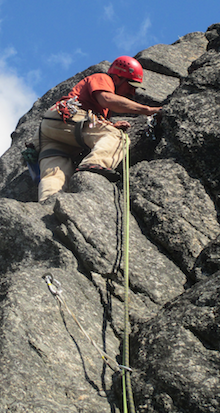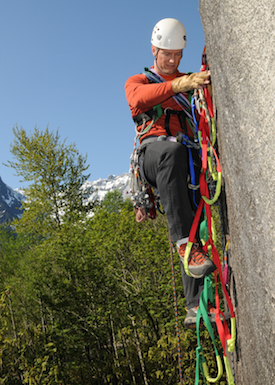Rock Climbing Terms: Styles and Techniques
by Tom Kirby
AAI Instructor and Guide
If you’re new to climbing, you may be puzzled by some of the terminology. Climbing styles and sub-disciplines, in particular, can be especially confusing. The minor distinctions climbers make between different ways of getting to the top of a cliff can seem unnecessarily arcane. And many terms mean different things, depending on the context.
Below is an introduction to some of the basic terms used to describe the different styles and techniques of rock climbing.
Top Rope Climbing vs. Lead Climbing
On small crags or practice boulders where there is a trail or some other easy route to the top (or in climbing gyms built specially for the purpose), it’s simple to protect the climber with a rope rigged from above, or top rope. Using a large tree or some other solid object at the top of the cliff as an anchor point, the climbers set up a line that passes from the belayer at the base of the cliff, up through a pair of carabiners, and back down to the climber.
As the climber moves up the rock face, the belayer takes in slack through a belay device that can lock off the rope in case of a fall. The belayer keeps the rope loose so that the climber receives no physical assistance, but benefits from the psychological reassurance of a “catch” should he lose his grip. In top roping, a falling climber usually falls no more than a few feet before the rope stops him.

A lead climber looks for a crack in which to place protection.
Jason Martin
On larger cliffs, or when climbers want a greater challenge, lead climbing techniques can be used to gain the top without using a rope from above. The leader still uses a rope for protection, but she trails it behind her. The climber who is following, also called the second, belays by paying the rope out through a belay device. As the leader moves up the cliff, she clips the rope through carabiners attached to anchors, either pre-placed bolts or anchoring devices she places in cracks as she goes. The anchor devices are called protection or simply gear.
In lead climbing, a fall can be a serious matter. If the leader slips when she is ten feet above her last protection, she will fall more than twenty feet before the rope, which stretches to cushion the fall, pulls tight and catches her. She may hit protruding ledges or ribs of rock on the way down, tumble over lower angle terrain, or swing violently and hit the rock face when the rope comes taut.
On longer climbs, a single climbing rope – typically about 200 ft.– is not long enough to reach the top. In this case, the leader stops at a ledge, builds a secure anchor from multiple pieces of protection, and belays the second up. Then they repeat the process, sometimes swapping the lead. Each rope-length is termed a pitch, and long climbs of this sort are called multi-pitch climbs.
Free Climbing vs. Aid Climbing
In the early days of mountaineering, climbers used a wide variety of tricks to surmount difficult stretches of rock. They installed ladders made of rope or steel, chopped stair steps into the rock, and even used gymnastic moves like shoulder-stands. A route on Mt. Watkins, in Yosemite, required that the first ascent party lasso a small tree from twenty feet below the summit. These maneuvers are the stuff of climbing legend.
As the sport evolved in the mid-twentieth century, and the use of new tools made more and more faces climbable, climbers began to distinguish sharply between the use of these artificial aids and climbing with no aids. Free climbing came to be defined as climbing the rock using only one’s hands, feet, and body for support and upward progress. The use of other methods was termed “direct aid” climbing, or simply aid climbing.
Free climbing can be practiced with or without a rope, but most free climbers do use a rope to catch them in case of an accidental slip. What distinguishes free climbing is that the rope is not used by the climber to pull himself upward. (In popular parlance, “free climbing” is sometimes used to refer to climbing without a rope for protection, but this is a misnomer. The correct term for this is "free soloing", described below.)

An aid climber steps up in an etrier. Alasdair Turner
In modern aid climbing, by contrast, the leader places tiny wedges, hooks, and other devices in cracks in the rock to use as anchor points. Having placed a piece of gear, he clips a short webbing ladder called an etrier to it and steps into it, using the ladder to gain enough height to place another piece of gear. He repeats this process until he has passed the difficult section or until he reaches the end of the pitch.
Aid climbing methods are often used on very long, multi-day routes called big walls. Portions of these routes can often be climbed free; aid is used to pass those sections that are particularly blank and featureless. Elite climbers spend years attempting to “free” routes and sections of big walls that have hitherto required aid, as Tommy Caldwell recently did on the Dawn Wall route on Yosemite’s El Capitan.
Solo Climbing
“Soloing” is an elastic term that is used to cover several different types of climbing that a lone climber practices without a rope, without a partner, or without either one. Depending on the method used, the objective being climbed, and the difficulty – not to mention the skill of the climber himself – soloing can be relatively safe or extremely risky.
A major sport in its own right, bouldering is a variant of soloing. In bouldering, climbers work on difficult moves, or problems, close to the ground, without a rope for protection. Serious boulderers often spot each other with outstretched hands and cushion the ground under a problem with pads to lessen the danger of a hard landing.
When a bouldering problem takes a rock climber high enough off the ground to make serious injury likely in the event of a fall, it is called a highball problem; highballs, in turn, shade into free soloing, or free climbing un-roped far above the ground, in which a fall means near-certain death. Two pioneers of this discipline, Derek Hersey and John Bachar, were among the best rock climbers of their time, but both lost their lives prematurely in ground-falls.
Roped soloing can refer to any of a variety of ways a climber can use a rope for protection without another person acting as belayer. Roped soloing techniques can be employed either on lead or on a top rope, for either free or aid climbing. Top rope soloing on small practice crags is not uncommon, but roped soloing on longer climbs is quite unusual. It takes more effort, is more time consuming, and places more reliance on technical systems than climbing with a competent partner.
Trad Climbing vs. Sport Climbing
Traditional climbing, or “trad” climbing, refers generally to the predominant style of rock climbing practiced in the United States throughout the 1960’s and 70’s, and, of course, still practiced today by many climbers. The ethos of this style emphasized risk, adventure, and complex problem solving. Climbers carried their own protection devices, which the leader placed in the rock and the second removed, leaving the climb more or less as the climbers had found it. Climbing a trad route can entail substantial route-finding challenges, as well as the risks of hard-to-place protection and long runouts – sections with no protection at all.
Beginning in the late 1970’s, rock climbers in Europe pioneered a new form of the sport – now called sport climbing – that emphasized athletic performance over the more traditional values of risk and adventure. Using power-drills and steel expansion bolts, they began placing permanent, fixed protection on difficult climbs, making it possible for climbers to safely take multiple falls while practicing hard-to-master moves. Sport climbers no longer needed to puzzle out what path a route might take up the rock; gleaming bolts, spaced as little as six feet apart, pointed the way ahead. Though less adventurous, the new style of climbing enabled a major advance in technical standards.
Today, both styles are common, but they are often associated with different locales. Yosemite Valley, California, for instance, may be the most famous trad destination in the world. Verdon Gorge in France and Smith Rocks, Oregon are famous for sport climbing.
Indoor vs. Outdoor Climbing
Perhaps the most recent major innovation in the sport of rock climbing is the indoor climbing wall, or climbing gym. Most major cities now have at least one indoor climbing gym where climbers can practice both top roping and sport leading skills. Modular, molded plastic climbing holds are regularly moved around by gym staff, making for an infinite variety of routes.
Still, few would deny that the best climbing is outside, on real rock, with all its natural variations.
Click on the link to see AAI’s introductory rock climbing course – taught entirely in the great outdoors.
Program Finder